Welcome to this week’s edition of the Plate Discipline Leaderboard. If you’re new to this post, the calculations of each metric are outlined below:
Plate Discipline A
O-Swing%
Inverse Contact % = (100% – Contact %)
2SwStr+1=(2*SwStr%+1%)
F-Strike %
The standard deviations above/below average for everything aside from F-Strike% is multiplied by three. Then, those three numbers are added to the standard deviation above/below average for F-Strike%, and that total is divided by four.
Plate Discipline B
Inverse xSLG = (100% – xSLG %)
The standard deviation above/below average is multiplied by one and one half.
Final Plate Discipline
The average of Plate Discipline A and Plate Discipline B.
[table id=76 /]
Mike Soroka
| Ranking | Final PD Grade | O-Swing% | Contact% | F-Strike% | SwStr% | K% | BB% |
| 22nd | 87.8% B+ | 33.2% | 78.8% | 60.4% | 9.6% | 22.1% | 9.1% |
I took a different approach when deciding which pitchers I wanted to talk about. Normally I take a look at any pitchers in the top 25 that stand out to me and then take a deep dive into what might be the catalyst for those skills. Today I want something slightly different. I’m going to take two pitchers who are experiencing surprising results and see if there are the underlying skills to support those results. With that in mind, I first want to look at what might be the hottest pitcher in baseball right now: Mike Soroka. After dealing with shoulder issues in spring training and starting the season on the IL, Soroka made his 2019 debut on April 18th and hasn’t looked back. Since then, over 36.2 innings he has given a minuscule four earned runs, which is good for a teeny tiny .098 ERA with an equally impressive 1.01 WHIP and 34 strikeouts. Obviously, most of that is unsustainable, but as per usual this time of year we are tasked with the issue of finding just how much of it is for real and how much is smoke and mirrors. Answering a question such as this one is exactly what these rankings are here for. Once we take a look at Soroka’s underlying skills and approach, we might be able to get an idea of just how tenable the numbers are. Take a look up above and you can see what we have to work with so far. They are pretty telling honestly.
His 33.2 O-Swing% is pretty average considering that is the 37th best O-Swing% of the 137 pitchers to face at least 100 hitters so far this season. That’s not even in the 25th percentile, so already we’re not off to a promising start. 78.8 Contact% isn’t great either. If you follow the idea that a good indicator of expected K% (eK%) is to take a pitcher’s Contact% and subtract it from 100.0%, he should be getting a roughly 21.2 K%, which practically matches his below-average actual K% of 22.1% (23.0 K% is considered average). We really don’t get too excited about a pitcher’s potential until we start seeing a K% closer to 25.0%. If you were a Soroka owner, you were likely hoping that he was simply getting unlucky with his low strikeout total; that doesn’t seem to be the case so far. Unfortunately, the SwStr% backs this up as well. The other way to find a player’s eK% is to take his SwStr%, double it and then add one to it. In this case, taking Soroka’s 9.7 SwStr% and doubling it while adding one would give you a roughly 20.4 eK%. As Nick loves to say HAISTFMFWT? or How Am I Supposed To Feed My Family With This? I can’t imagine Soroka continuing to be successful at all with such a low K%. To make matters worse, he’s walking way too many batters (9.1 BB%) and his poor F-Strike% of 60.4% supports that. For perspective, that F-Strike% is 83rd out of the 137 pitchers we graded. xSLG isn’t positive either, as it shows that his current .214 SLG has been the product of some pretty heavy luck and excellent defense.
We could likely stop there and be pretty justified in declaring that Soroka has far too many red flags to continuing pitching at an elite level, yet I want to go a little bit deeper. The thing is that Soroka has achieved a high level of success so far this season. While it would be easy to simply chalk it all up to luck and defense, I always prefer to see if there is another force at work that might be driving his small sample success. If you’ve read my previous plate discipline pieces, you know that my next stop almost always is to inspect the pitcher’s approach, so I hope you’re ready for some heat maps! First though, let’s talk pitch mix. Soroka boasts a four pitch arsenal with a four-seamer, sinker, slider, changeup combo. Here are their usage rates and pVAL/100:
| Category | Four-Seam | Sinker | Slider | Changeup |
| Usage % | 16.0% | 48.0% | 26.2% | 9.9% |
| pVAL/100 | 2.44 | 2.88 | -1.70 | 1.13 |
I’m always encouraged when I see a pitcher throwing their best pitches most often and in Soroka’s case that’s is his excellent sinker. If you combine his three positive pVAL pitches together, he is currently throwing a positive pitch right around 74.0% of the time, which is encouraging. Now mind you pVAL is a results-based stat, so if Soroka was getting luck or defense-based help these numbers would be skewed as well, but I do find it encouraging that he is recognizing his best pitches and throwing them more often than not.
Now, what about location? Here is the heat map for his primary pitch, the sinker:
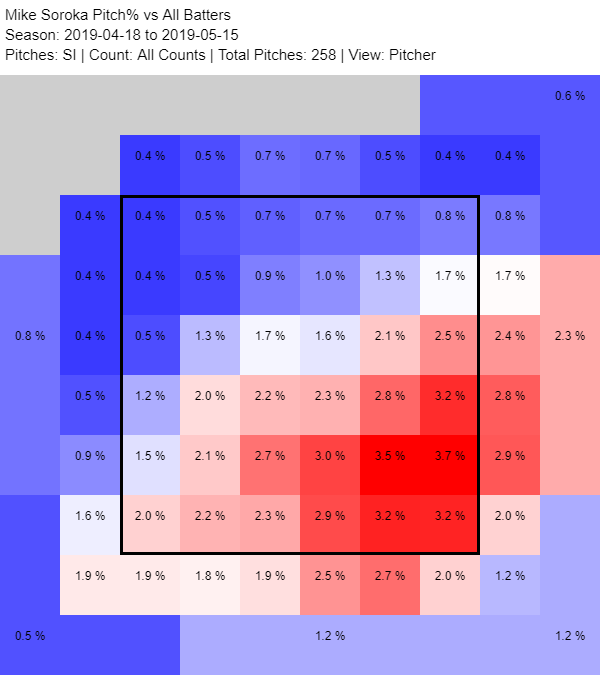
If you’re going to rely on sinker as your main pitch (which I don’t normally recommend) you can’t ask for better placement than this. It sits down and in on the hands against RHBs while diving down and away to lefties. He’s hitting both corners down in the zone, which gives us a pretty good idea of why the pitch has been so successful. Even when regression comes looking for Soroka (and it will), if he can continue to locate his sinker this well that may very well help cushion that regression some.
Now let’s take a look at Soroka’s fastball.
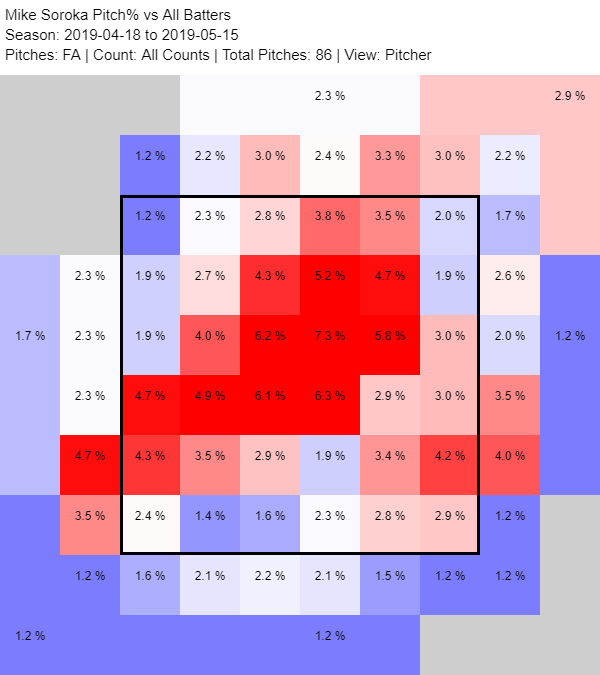
I would love to see Soroka’s fastball end up dead center of the zone WAY less often, but otherwise much of the pitch’s locations are still encouraging. He’s able to paint the corners on either side of the plate and is throwing it up in the zone as well. Despite this, this is the pitch that causes me the greatest concern. He can’t possibly continue to throw his four-seamer in the heart of the plate 48.8% of the time and not expect it to get rocked at some point. If Soroka wants to continue his early season results, this will have to change—it will have to change fast.
Now on to the slider.
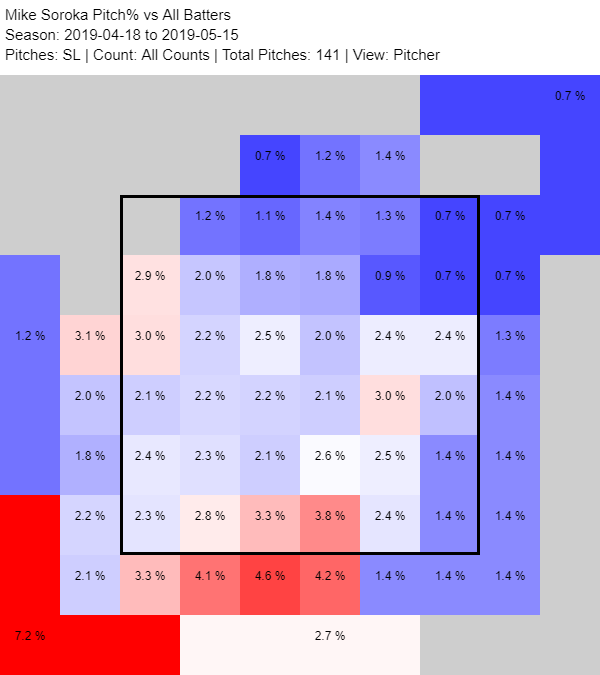
Here we see the issue with Soroka’s slide piece. It has its heart in the right place, down is where that slider wants to live for sure, but he has to be able to establish that he can throw the pitch for strikes before it will really be effective. If you were wondering where most of Soroka’s control issues have come from so far this year, I think this pitch is giving you the equivalent of the look your dog gives you when you come home to find the couch shredded. Getting tighter control of this pitch could be the key to that K% finding real growth down the line.
Finally, the changeup. Much like the four-seamer, I wish it caught less of the plate, but if he’s using it as a way to get lefties out then the rest of the location is pretty perfect: down and away.
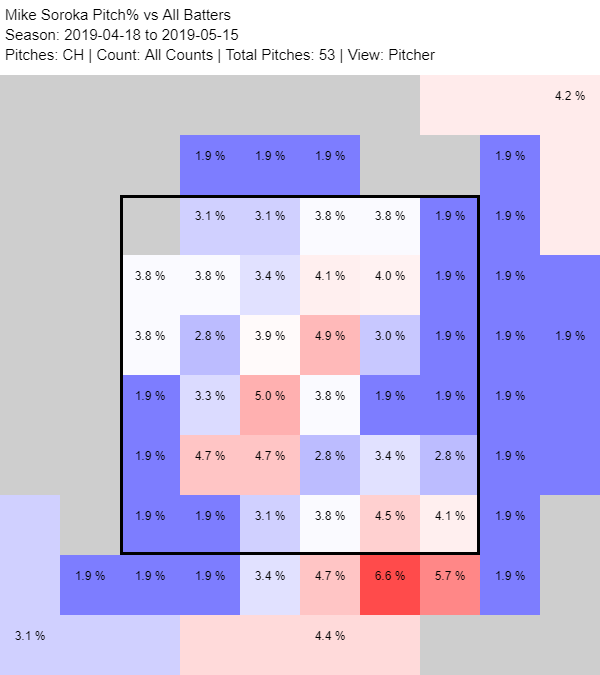
There’s no real way to know for sure, but it seems like a lot of Soroka’s success so far has been a blend of luck (see that four-seamer location) and great control designed to draw poor contact. The last thing we want to take a look at though is the Braves defense. The Braves D has largely been considered middle of the road this season and this recent article by Jay Jaffe over at Fangraphs tends to back that up. FIP and SIERA don’t differentiate between luck and defense, so we’ll have to sort of intuit that for ourselves, but they do seem to indicate that some mixture of luck and defense are playing a role in Soroka’s season. Check it out.
| ERA | FIP | xFIP | SIERA |
| .098 | 2.89 | 3.96 | 4.14 |
It’s undeniable that there are quite a few forces outside of Soroka’s control that are affecting his season so far; I like to think with the heat maps we’ve likely found the culprit in his four-seamer. A pitch thrown that often in the heart of the plate should be getting hit HARD and so it’s likely by a combination of luck and defense that it hasn’t yet. Now, this isn’t meant to be all doom and gloom. A lot of folks would simply regress his numbers to that FIP or SIERA number and I’m not willing to do either. His K% is too low and his BB% too high for him to be a 2.89 pitcher, but the control and command of his best pitch makes me think he’s not a 4.00+ ERA pitcher either. It feels more likely that he is somewhere in between. If I had to make a guess, he’s more like a 3.50 ERA pitcher rest of season, which is still extremely valuable, but if you can find someone who is willing to buy into the breakout I think you have to sell, and sell hard if the offer is right.
| Ranking | Final PD Grade | O-Swing% | Contact% | F-Strike% | SwStr% | K% | BB% |
| 41st | 84.0% B | 30.4% | 78.3% | 57.0% | 10.2% | 24.1% | 8.9% |
Aside from a rough start two days ago, Jake Odorizzi has been a revelation for the surging Twins, putting together a fantastic 2.63 ERA with a 1.06 WHIP and 46 strikeouts in 48.0 IP. As with Soroka, our goal is to hopefully use the rankings as a springboard to determine how much of Odorizzi’s success is skill-based, process-based, or luck-based. Again let’s start with the plate discipline stats we have for Odorizzi. At first glance, they look remarkably similar to what Soroka has been doing so far this season. The biggest difference between the two of them is in eK%. While he has a pretty low O-Swing% much like Soroka, Odorizzi’s SwStr% and Contact% tend to indicate that he has a much higher K%, as his eK% is 24.6%, which supports his 24.1 actual K%. Odorizzi also struggles with his command, as indicated by his poor F-Strike%. xSLG indicates that he should be due a negative regression of almost 100 points, much like in Soroka’s case. Again it would be totally understandable if you thought it made sense to call it right here and now, especially since we just saw how this plays out with Soroka. With that being said, all human beings are unique and frankly we could use the practice, so let’s follow the same procedure we just did for Soroka and see if we can find any clues to Odorizzi’s early season success.
Let’s start with Odorizzi’s Usage and pVAL/100 numbers. He throws four different fastballs including a four-seamer, sinker, split-finger, and cut fastball, to go along with a slider and a curveball. Here are the stats for those pitches:
| Category | Four-Seam | Sinker | Splitter | Cutter | Slider | Curveball |
| Usage % | 36.3% | 19.8%% | 13.9% | 5.8% | 11.9% | 12.4% |
| pVAL/100 | 2.59 | 0.11 | 0.86 | 2.41 | 2.20 | -1.43 |
Once again, I love seeing a pitcher taking his most successful pitches and throwing them the most. The interesting is that the only real difference from last year to this year is that he essentially flipped usage between his curveball and his cutter. So that likely isn’t the reasoning for Odorizzi’s success. How about his pitch locations? Note that I’m going to skip his cutter, as while he has gotten good results so far with it, he’s only thrown it a handful of times and thus it is hard to draw conclusions from it.
Anyways, on to the four-seamer!
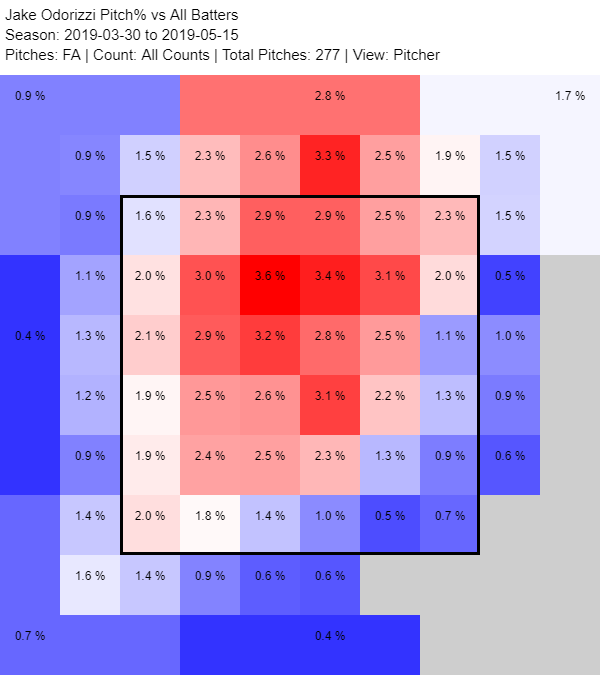
Holy cow, that’s way too many fastballs right down the pipe. The red up in the zone is a good sign, but just like with Soroka, you can’t let your four-seamer get that much of the plate that often and not get walloped. It’s going to catch up with him at some point. Combine this with the less-than-promising plate discipline numbers and I’m already pretty solidly in the luck/defense realm again.
Let’s move on to his sinker.
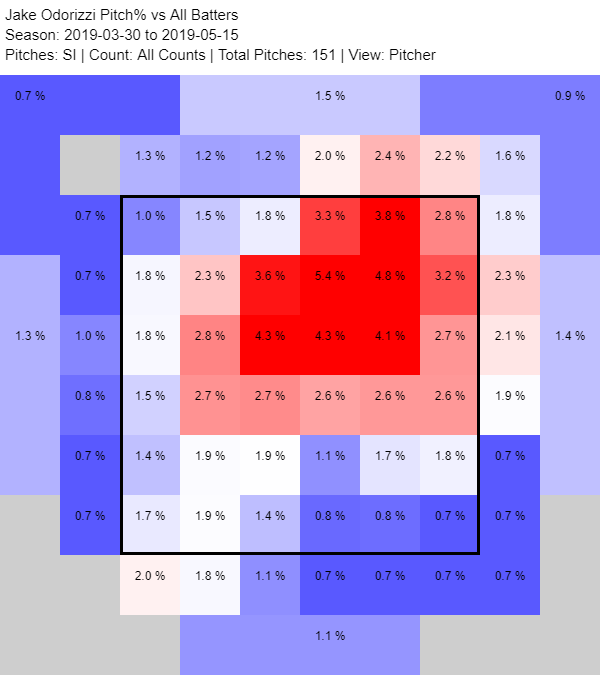
Yikes. That is also not what you want to see. If you’re going to throw a different type of fastball, I firmly believe that it needs to serve a different purpose than your other fastballs. Throwing a sinker up in the zone like that is not a different purpose. Might as well throw the four-seamer more often and continue to pound the upper part of the zone. Once again there are far too many sinkers ending up dead-red right down the heart of the plate. At the moment 34.4% of his sinkers are ending up meatballs. When you combine that with the fact that 26.5% of his four-seamers are home run fodder, this doesn’t spell long-term success for pitches that he throws 56.1% of the time. I repeat again: This has to catch up to him sooner rather than later.
How about the breaking stuff? Here’s the slider:
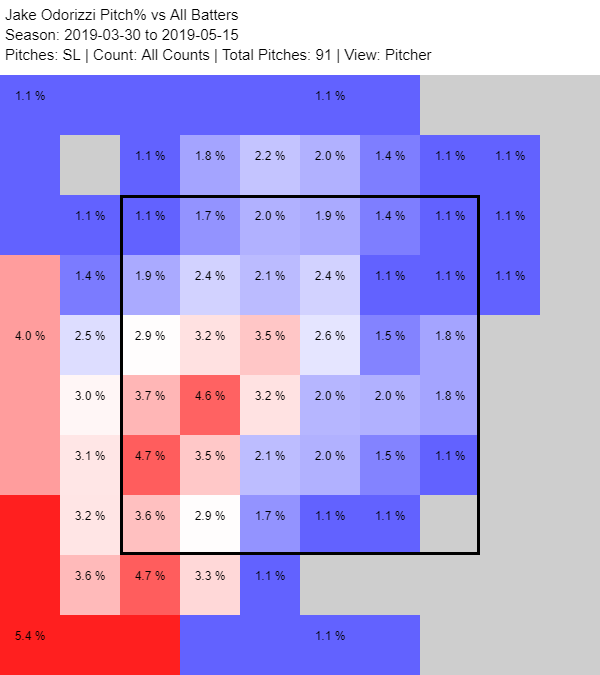
This is a pretty darn good set of locations for his slider. It’s down and in to lefties and down and away to righties, which is exactly what you want to do with your slider. If you look at the locations, it avoids a lot of the middle zones and really only ends up in the areas that the hitter really can’t do anything with. If there was one pitch that I found encouraging for Odorizzi’s 2019, this pitch is it. I would love to see him really ramp up his slider usage based on how effective it has been (2.0 pVAL already!).
Now from the positive to the negative: We have to talk about Odorizzi’s curve. Here’s its heat map:
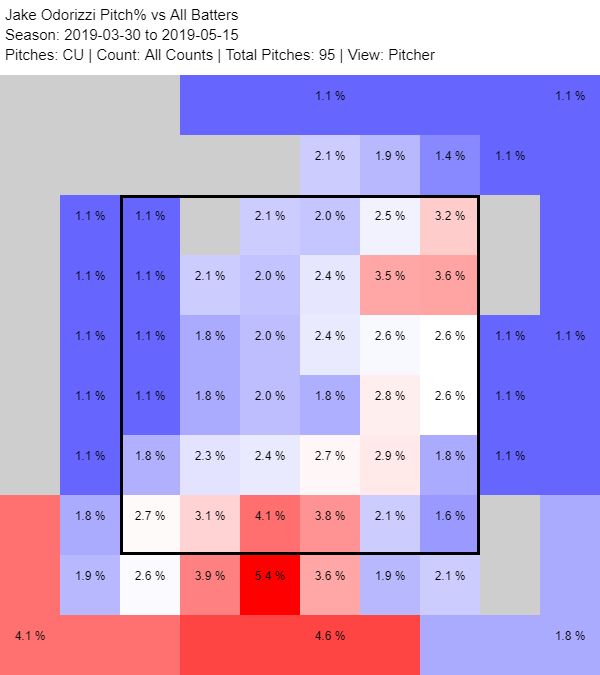
Other than that small patch up in the zone, this is where you want your curveball—with one major flaw. Odorizzi’s curve is a testament to the idea that you have to be able to throw your breaking balls for strikes or else they simply become vehicles for walking hitters. The pitch has a terrible 31.6 Zone% and a mere 30.8 O-Swing%, which means that most hitters aren’t fooled by the pitch at all. They read the spin or velocity of Odorizzi’s curveball and they know not to swing; this is evidenced by both the above stats and the tiny 6.3 SwStr% and -4.8% K-BB%. Perhaps if he throws his curveball less often and his slider more, it can make up for the regression due to his fastballs, but I am skeptical that at some point the wheels don’t completely come off and his fastballs start getting hit (and hit hard). The predictive stats back up my concerns:
| ERA | FIP | xFIP | SIERA |
| 2.63 | 3.40 | 4.65 | 4.47 |
With excellent defenders such as Jorge Polanco at SS and Byron Buxton in CF, it isn’t surprising that Minnesota’s defense (and to some degree the ballpark as well) and getting to face the weak AL Central has played a large part in Odorizzi’s success. It’s also pretty reasonable to consider that luck itself has had a huge impact in what Odorizzi has managed to do so far in 2019, especially when you take his fastball location into consideration. Given his lack of plate discipline implied skills and a less-than-solid approach, I expect harsh regression for Odorizzi and pretty soon he’ll return to the 4.00+ ERA pitcher he has been his entire career. If you have someone interested, this is also a hard sell. Whereas Soroka is a talented, young pitcher who should still be valuable despite incoming regression, Odorizzi strikes me as the kind of chariot that is going to turn into a pumpkin the moment the clock strikes midnight. And midnight is a lot closer than we think.
(Photo by Mark Goldman/Icon Sportswire)
